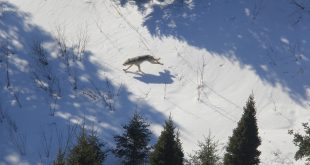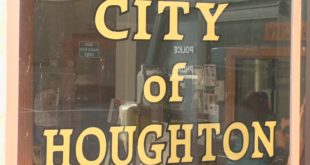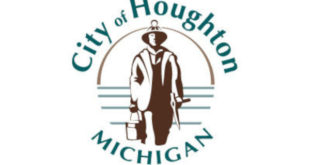Gladstone, MI — On Tuesday and Wednesday, May 7 and 8, 2019, Hiawatha National Forest fire personnel successfully conducted two prescribed fires in the Raco, Michigan, area. The 573-acre Rifle Range Prescribed Fire and 237-acre Porcupine Prescribed Fire both served the ongoing objectives of improving wildlife habitat and reducing hazardous fire fuels.
“We were fortunate to have two consecutive days with excellent weather conditions followed now by rain,” noted Eric Rebitzke, Fire Management Officer for Hiawatha and Ottawa National Forests.
In addition to the resource and community wildfire preparedness benefits, these two prescribed fire projects gave the Forest the opportunity to utilize aerial ignition techniques for the first time. Before beginning each of the burns, a crew of firefighters burned a strip around the perimeter of the project to create a fuel break. Then, a helicopter flew over the project area to dispense lit fuel spheres that look very much like ping-pong balls. A “plastic sphere dispenser” punctures and ignites each sphere and then ejects it through the open door of the aircraft. On the ground, the burning fuel ignites the grasses and other fuels that naturally build up over time.
“Traditionally, crews of wildland firefighters light prescribed burns by methodically walking through the area using drip torches to spread fire,” explained Brenda Dale, a US Forest Service Zone Fire Management Officer stationed on the Hiawatha.
Dale explained that using a “lighting crew” is a very reliable method that is ideal for certain scenarios, but that for larger landscape burns the traditional method requires a relatively longer period of suitable burning conditions to implement a burn.
By contrast, aerial ignition methods (using either fixed- or rotary-wing aircraft) are especially useful in certain scenarios, including when the prescribed conditions for lighting a controlled fire are expected to occur within a narrow timeframe, and when large or widely dispersed land units are being treated within the same day.
“Many Forests routinely use aerial ignition, so this was a strategic opportunity to bring the tool to the Hiawatha both for project accomplishment and also for training,” said Martie Knipe, Assistant Zone Fire Management Officer.
Knipe noted that Forest Service fire personnel regularly assist other units conducting prescribed fires, so familiarity with a variety of firing techniques is important. In addition, because the Rifle Range Prescribed Fire was conducted on lands formerly managed by the Department of Defense, aerial ignition minimized direct exposure to the possible safety hazard of unexploded ordnance.
There are many important reasons to use prescribed fire as a management tool, but fires always generate smoke. Smoke impacts are specifically assessed as part of the planning for a burn. The smoke impacts from these burns were modeled prior to ignition. Mitigation measures included the use of aerial ignition, which minimizes the burn period and also builds heat quickly which causes the plume to lift higher into the atmosphere and thereby reduce impacts. It is also important to know that the amount of smoke released during a prescribed fire is much less than during a wildfire; the weather and fuels conditions can be chosen during a prescribed fire so that only the desired amount of fuel is consumed. During a wildfire weather and fuel conditions are usual near the very dry end of the scale and the amount of fuel consumed (and smoke produced) is much greater.
In recent years, Hiawatha National Forest fire specialists have been studying the historic role of fire in Michigan’s Upper Peninsula, and while the findings are not complete, it is clear that fire was historically more frequent in UP forests than it has been over the past 100 years. Fire managers anticipate expanding the use of controlled burning as tool to better manage its ecosystems.
“Introducing prescribed fire has many potential benefits,” said Rebitzke. “Controlled fire can help maintain wildlife habitat, reduce certain pests (e.g. ticks), and reduce hazardous fuel loads — not to mention improving blueberry and morel harvests!”
The US Forest Service is committed to improving sustainability of the nation’s forests, creating resilient ecological communities, and assisting human communities minimize risk of catastrophic wildfire. The 2012 Duck Lake Fire, caused by lightning, consumed 21,069 acres of State and private lands and destroyed 136 structures, 49 of which were either cabins or homes.
Sustainably-managed national forests provide other benefits as well to the American people. Those benefits include providing clean drinking water (to more than 180 million people), wood products, and recreation settings for tourism. Estimates indicate, for example, that Hiawatha National Forest supports 980 jobs in the local area and contributes $34.5 million in labor income for wage earners and businesses.
“We are proud of the benefits national forests bring to our communities,” said Rebitzke, “and controlled fire is a key element in that success.”
To learn more about the Hiawatha National Forest’s prescribed fire program for 2019, visit our webpage (https://www.fs.usda.gov/detail/hiawatha/news-events/?cid=FSEPRD617726) or contact Eric Rebitzke at 906-428-5856.
 Keweenaw Report Your Source for Local News and Sports
Keweenaw Report Your Source for Local News and Sports





